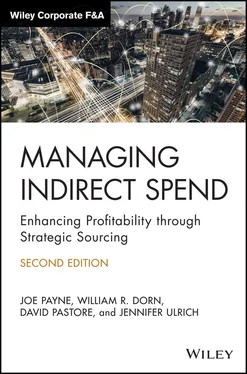Other service levels are more specific to the product or service provided and are often referred to as the scope of work. Examples include a minimum amount of cleaning per week for a janitorial agreement or the maximum number of service calls accepted for a hardware maintenance agreement. Understanding the scope‐of‐work details is important when introducing your requirements to alternate vendors and for validating an apples‐to‐apples comparison of proposals.
For example, if you are about to engage in a sourcing effort for janitorial services, your real requirement is keeping your building clean. However, this requirement is fairly subjective, and most lawyers will not allow that type of guarantee into an agreement. On the other hand, outlining a schedule for the frequency of the cleaning (three days a week) and listing the types of cleaning services (dusting, vacuuming, bathrooms, windows, etc.) can give some assurances that the building will be satisfactorily cleaned. If, later on, you find that the building is not properly cleaned, you can refer back to the scope of work and verify that the supplier is performing the list of services specified in the contract.
Specifications, which define specific criteria regarding attributes, quality, or performance, are typically included in a purchasing agreement for products. Specifications are often defined in raw materials agreements but can be overlooked when dealing with indirect spend categories. However, understanding specifications for indirect spend categories can be just as important. Let's use office supplies as an example. In your organization, you might have some employees who use standard blue, ballpoint pens and others who require felt‐tipped pens. Some pens may have a special type of grip. And the executive or Sales team might have specially made pens with a logo or other features. In this scenario, asking a supplier to price out pens results in receiving a very diverse set of quotes.
In areas like office supplies, you might find it nearly impossible to get a good idea of specifications for every potential purchase. You probably buy many different types of pens, staplers, and paper clips, among other items. How can you be expected to sit down with everyone within your organization who purchases office supplies to understand what it is they purchase? That process is time consuming at best and, in many cases, just unfeasible.
Rather than interviewing each end user about the specifications of hundreds of different products, you can collect this information from the current supplier by requesting the manufacturer name and part number to be provided in a line‐item usage report. If the goods are purchased through a distribution model (in which the manufacturer sells the goods to the distributor and the distributor sells the goods to you), the manufacturer part number provides competing suppliers with a good indication of the exact product being purchased and ensures an apples‐to‐apples comparison.
While requesting the manufacturer part number works well in a distributor model (or a model in which the products purchased are standardized), it will not help if the product you are purchasing is customized (or semi‐customized) for your organization.
Examples of customized products might include corrugated boxes or printed marketing materials. In these cases, asking for the manufacturer part number will not give you the information you need to understand what is being purchased, nor will it provide alternate suppliers with a clear understanding of your requirements. If you are not already familiar with the products being purchased, you can take several steps to quickly get up to speed on important specifications.
First, during the supplier interview, ask suppliers to detail the factors that affect the cost of the product—specifically those related to the construction of the product. For a corrugated box, ask them to provide specifications, such as box dimensions, box strength, color, and other relevant factors.
Second, take a look at similar products being purchased online. What do suppliers indicate as important specifications when selling their products? In some cases, suppliers might even put a quote form on their website. What information are they asking for in order to provide quotes?
Lastly, ask the supplier for a specifications sheet, which can give you a precise list of all the important specifications tied to a particular product. A word of caution—if you are purchasing a product that is proprietary to your current supplier (this is the only supplier in the market who sells it), the supplier may ask you to sign a nondisclosure agreement before providing you with specifications. In this case, you are obligated not to share the specifications with others outside your organization, including competing suppliers.
THE FINAL ANALYSIS: BUILDING A BASELINE
By now, you have collected a wealth of information—line‐item pricing reports, contracts and pricing agreements, and scope‐of‐work/specification documents. You have interviewed end users and suppliers to better understand some of the more subjective aspects of the relationship. It is now time to build your baseline document.
The baseline document is a summary of everything you have learned during the Data Collection phase. This document comes in handy when reporting back to end users, developing RFPs or other bid documentation, and comparing proposals later on during the initiative. It is also used to calculate any savings achieved during the initiative.
The baseline document converts your data into four types of information:
1 Pricing information (including an analysis of line‐item detail)
2 Service‐level information
3 Contractual requirements
4 Go‐forward strategy
When dealing with pricing information, start from the highest summary level you can and break the data down from there. The baseline price analysis should start with a recap of total spend (by supplier) for the category. If you have multiple suppliers, demonstrate the spend by each supplier separately and then provide a total.
Then, review the spend and see if it can be categorized by product or service type. For example, in a services baseline (such as maintenance for your HVAC systems), you might break out the spend to show how much represents scheduled maintenance and how much represents service calls. If your organization has multiple facilities, you may want to break out the spend by location as well.
The pricing analysis also includes a summary of ancillary or other incurred fees, such as minimum order penalties, fuel surcharges, and overtime charges. It is important to note not just what these charges are, but how often they are incurred and the reasons why they are incurred.
Next, summarize the current cost structure. Are you paying at a discount from a list price? Are you getting net prices across the board, specific to certain volumes or ordering patterns? Is pricing based on a markup structure by category?
Finally, provide a spreadsheet showing usage history and price point paid. Analyze the data to demonstrate ordering patterns, high volume items, and which products or services represent the most spend. All of this information will be used later on to develop a sourcing strategy. It can also help relay requirements to alternate vendors.
The service‐level section of the baseline should provide a clear recap of service‐level requirements. These include requirements that are listed in a contract or pricing agreement as well as those identified by end users. Review these service levels to determine which are true necessities for your organization (needs) versus value‐adds that may not be necessary (wants). If it appears that you are paying for more service than is required, your assessment should make a clear distinction between minimum requirements and options that are nice to have but not required.
Читать дальше












